Tender, bright-hued sweet potato gnocchi are beautiful to behold and a delight to eat. Their sweet and savory flavor is perfect for fall, especially when paired with a simple sauce of garlic-infused olive oil and crispy sage.
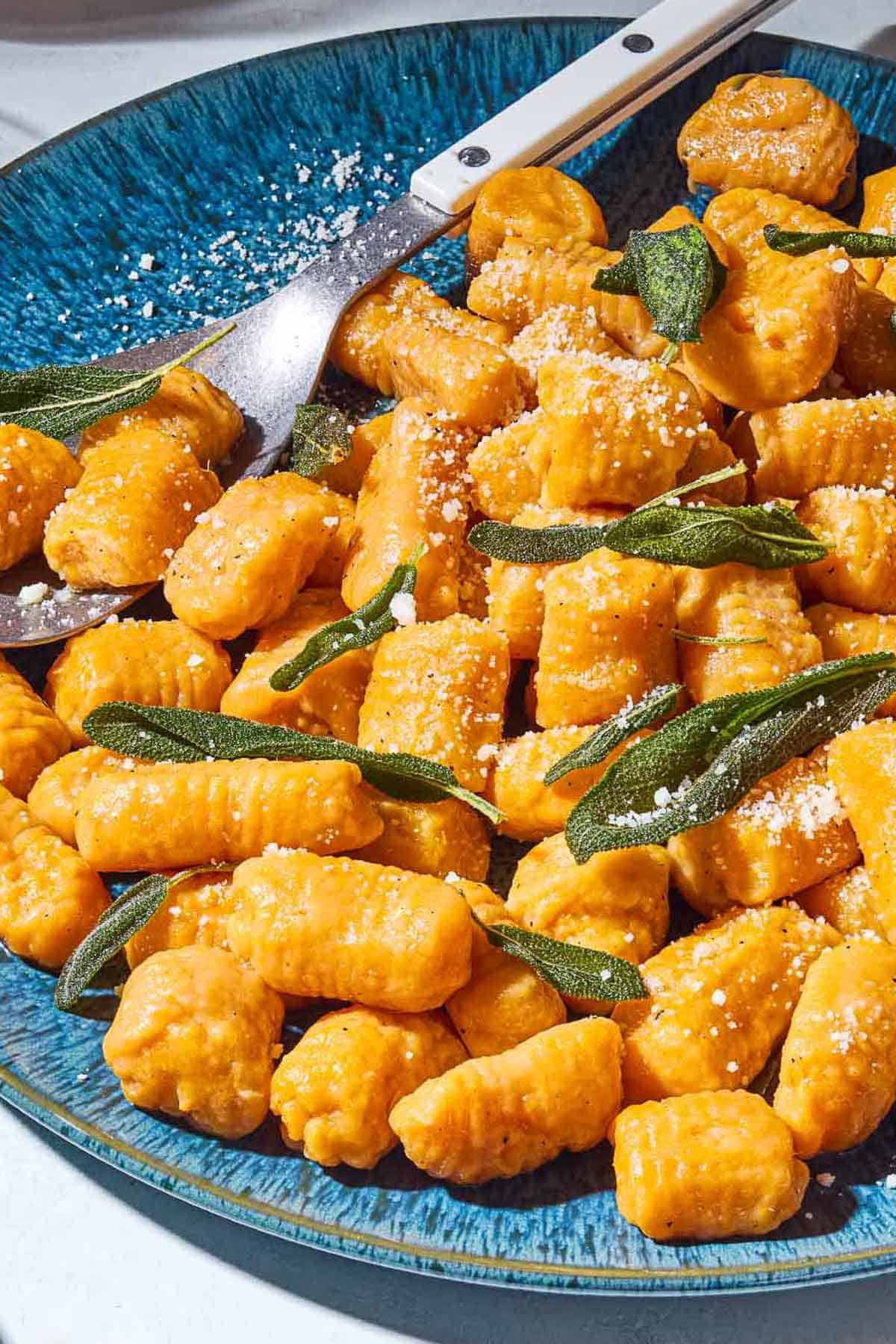
Most of us are familiar with classic potato gnocchi, those fluffy bite-sized dumplings that are a Sunday dinner tradition for countless Italian families. But what about gnocchi made with sweet potatoes?
While working on my cookbook Rustic Italian, I started to play around with my standard potato gnocchi recipe and came up with a colorful riff using sweet potatoes. Even now, a decade after the book was originally published, it’s still one of my family’s favorite meals.
The combination of sweet and savory flavors in the sweet potatoes themselves, plus their tender texture and beautiful orange color make these gnocchi so special. Dressed with a simple sage and extra virgin olive oil sauce, they have a “wow” factor that always delivers. But don’t just take my word for it. Make a batch and you will soon see for yourself!
Making any kind of pasta from scratch is a labor of love that takes some practice to perfect, but it’s easier than you may think. Plus, even if your first batch of gnocchi isn’t picture-perfect they’ll still taste incredible!
Table of Contents
- What is Sweet Potato Gnocchi?
- Ingredients in Sweet Potato Gnocchi
- Best Sweet Potatoes for Gnocchi
- Tools for Sweet Potato Gnocchi
- How to Make Sweet Potato Gnocchi
- Prep the Sweet Potatoes
- Form the Sweet Potato Gnocchi
- Cook the Sweet Potato Gnocchi and Make the Sage Sauce
- Sweet Potato Gnocchi Tips
- What to Serve With Sweet Potato Gnocchi
- More Gnocchi Recipes to Try
- Sweet Potato Gnocchi Recipe
What is Sweet Potato Gnocchi?
Sweet potato gnocchi is a type of boiled potato dumpling eaten with a sauce similar to how you would enjoy pasta. These delicious little nuggets are a riff on classic potato gnocchi, which are said to have originated in the southern Italian city of Sorrento. This version substitutes sweet potatoes for baking potatoes. That one change makes a big difference in appearance, added nutrition, and flavor!
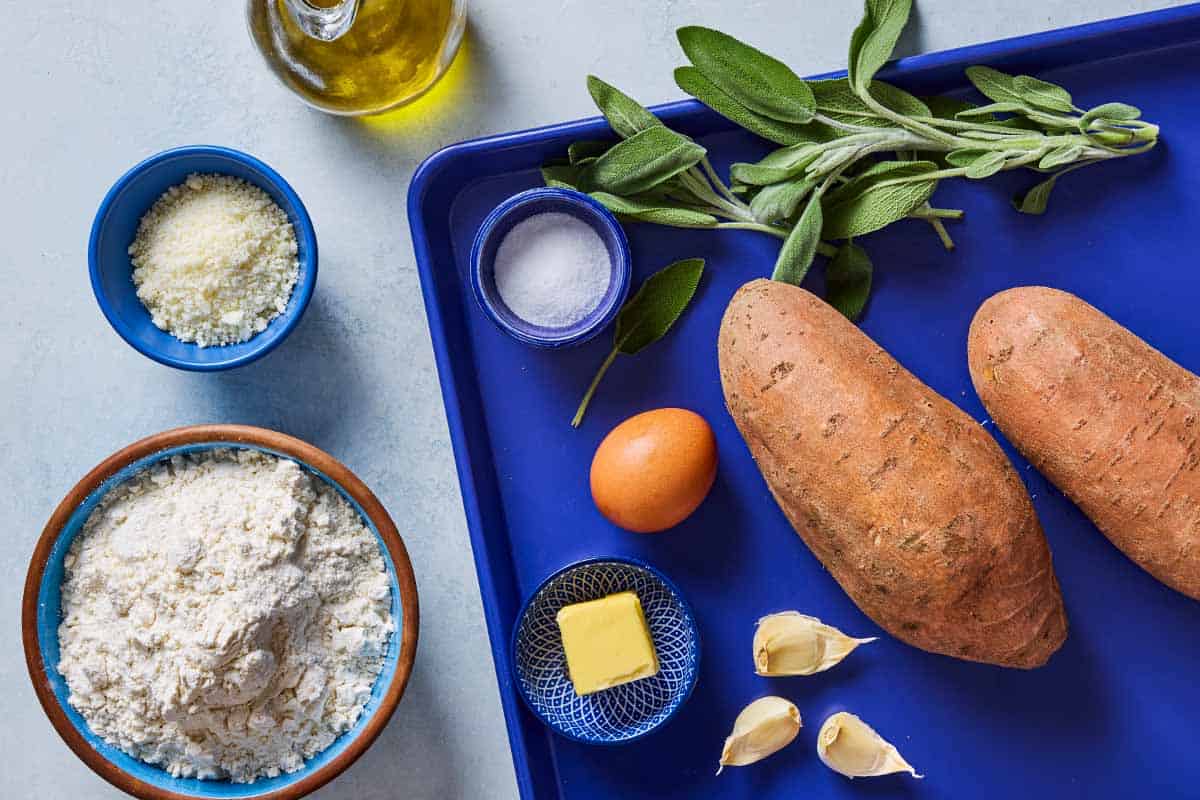
Ingredients in Sweet Potato Gnocchi
It takes only four ingredients to make a batch of gorgeous, orange sweet potato gnocchi, plus a few extra ingredients for the super simple olive oil and sage sauce. Here’s what you’ll need.
- Sweet potatoes: For gnocchi with a glorious orange color and smooth, tender texture, look for sweet potato varieties with deep orange flesh and not too much fiber. My favorite is a Garnet sweet potato (also known as Garnet yam), which has russet skin and a long, tapered shape.
- Flour: All-purpose flour helps absorb moisture and turn the cooked sweet potato flesh into dough. You’ll need flour for the dough for flouring your work surface.
- Egg: A single egg helps to hold the gnocchi together and gives them a bit more body and richness.
- Salt: A dash of salt tempers the sweetness of the potatoes and rounds out the flavor of the gnocchi.
- Extra-virgin olive oil: Good olive oil forms the base of the sauce for your sweet potato gnocchi. Make sure it’s a good-quality olive oil with a fresh, buttery flavor, like our Nocellara Italian olive oil.
- Butter: I like to add just a small amount of butter to enrich the sauce for sweet potato gnocchi, but you can leave it out if you prefer. Just add more olive oil to your sauce.
- Garlic: Lightly crushed garlic punches up the simple olive oil sage sauce.
- Sage: Fresh sage is one of my favorite herbs, especially in fall. Its savory, woodsy flavor beautifully complements the sweetness of sweet potato gnocchi.
- Parmigiano-Reggiano cheese: A shower of freshly grated Parmigiano at serving time brings together all of the sweet and savory flavors in this stellar dish.
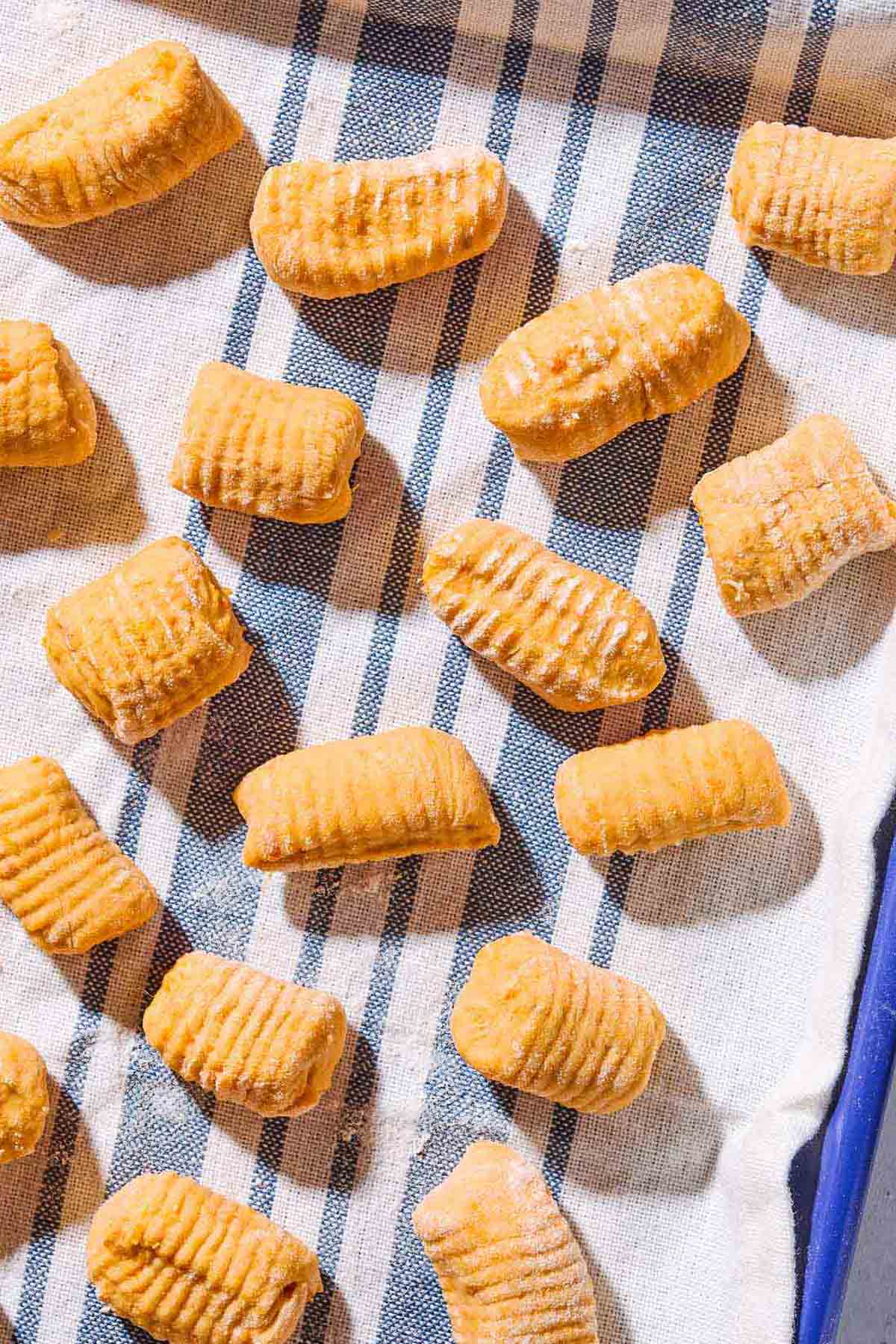
Best Sweet Potatoes for Gnocchi
Every year, I seem to find more and more varieties of sweet potatoes at my local farmers’ market and even at the supermarket. They range in color from bright orange to deep purple to creamy white. Here are some of my favorites for making sweet potato gnocchi.
- Garnet: Slender and long in shape, Garnet sweet potatoes have bright orange flesh that is super sweet and smooth when cooked. For gnocchi with that glowing orange hue, this is your best bet. Just know that because Garnet sweet potatoes have a fair amount of moisture, they need to be drained after cooking before turning them into gnocchi!
- Beauregard and Jewel: Rounder and fatter than Garnet sweet potatoes, and with lighter skin, Beauregard and Jewel sweet potatoes have pretty orange flesh. They can be more fibrous than the Garnet variety, so be sure to rice or mash them thoroughly.
- Purple sweet potatoes: Yes, you can make gnocchi using purple-fleshed Japanese sweet potato varieties such as Okinawa! Obviously, this is not the variety you want to choose for orange sweet potato gnocchi. But purple sweet potatoes make fantastic gnocchi with a gorgeous amethyst color. Purple sweet potatoes are less sweet than orange varieties, but they’re also starchier and less moist, which makes it less fussy to work with.
- White sweet potatoes: Hannah and Satsuma-Imo are two varieties of white-fleshed sweet potatoes. Hannah has tan skin, and Satsuma-Imo’s skin is purple. The flesh of both varieties is actually more of a cream color. Satsuma-Imo has an especially delicate, sweet floral flavor. These varieties make delicious sweet potato gnocchi, but they do lack that spectacular orange hue and look more like standard potato gnocchi.
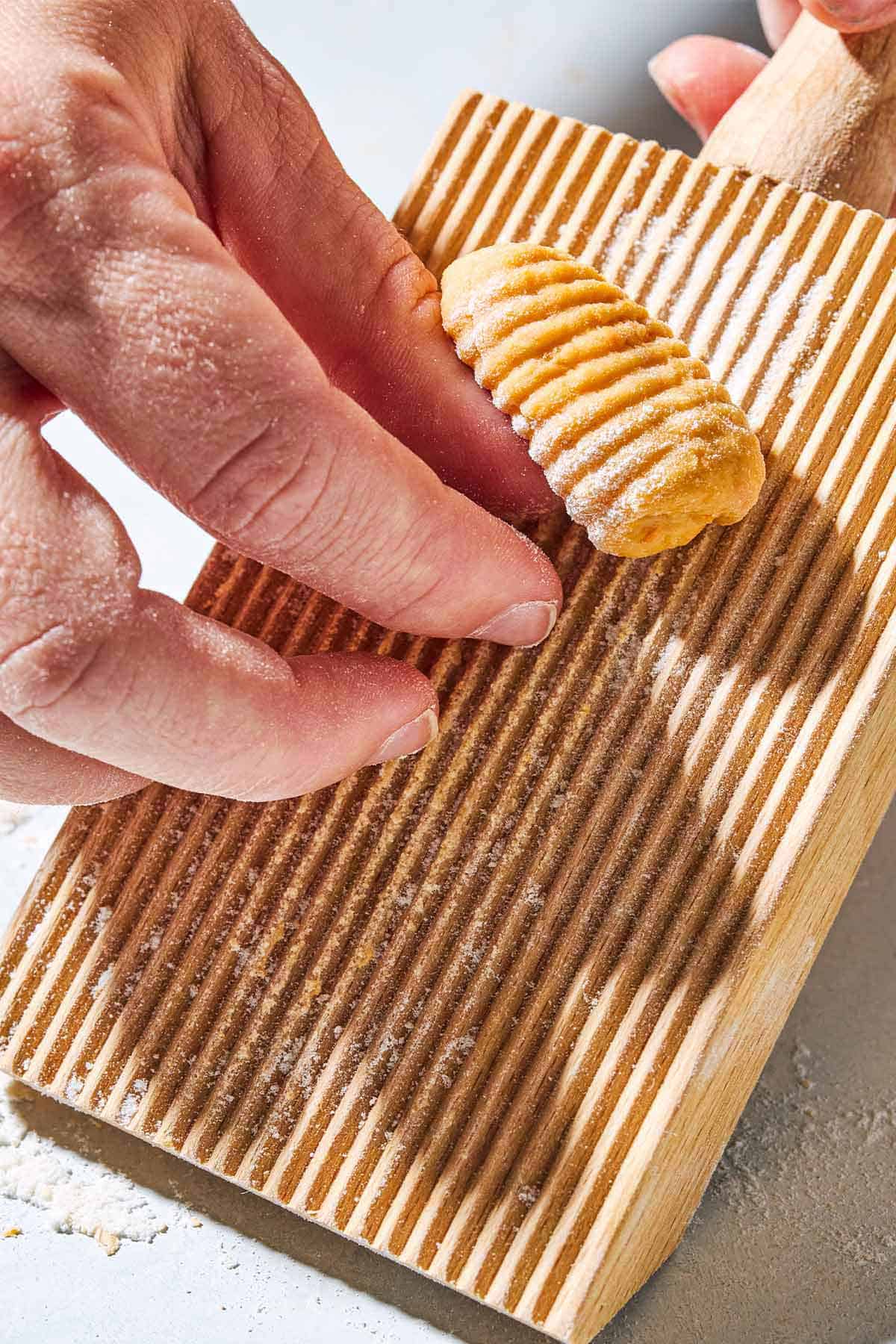
Tools for Sweet Potato Gnocchi
You don’t need anything fancy to make sweet potato gnocchi, but there are a few tools that make it easier.
- Cheesecloth or paper towels: It’s important to drain away excess liquid from the cooked sweet potatoes. A doubled-up layer of cheesecloth set into a colander does a good job. But if you don’t have cheesecloth, several layers of paper towels or a flour sack-style cotton or muslin dish towel will work just as well.
- Potato ricer: A ricer is a manual appliance typically made from stainless steel with long handles resembling a large garlic press. A potato ricer “rices” potatoes by pressing them through a disk with small holes. This yields an airy mound of potatoes, rather than a dense mash or purée. If you don’t have a ricer, a food mill produces a similar effect. Otherwise, mash the potatoes with a fork or a potato masher, fluffing them as you go to incorporate air.
- Bench scraper: I use a bench scraper for a couple of steps. One, it helps incorporate the flour into the potatoes without over-mixing or over-handling the dough. Second, I use it to cut the dough into portions, and later into bite-sized nuggets. If you don’t have one, you can mix the dough by hand and use a knife to portion and cut the ropes of dough into gnocchi.
- Gnocchi board: This simple tool is called a “rigagnocchi” in Italian. Rolling your gnocchi down the length of the board creates beautiful, even ridges on one side, and a depression from your thumb on the other. The purpose for this shaping is two-fold. First, the depression helps the gnocchi to cook evenly. Second, both the depression and the ridges help “capture” sauce, making your gnocchi even more delicious. Gnocchi boards are inexpensive and can be found online (I like Fante’s Gnocchi Board). But even without one, you can roll your gnocchi down the inside of a fork. The ridges will be wider, but the effect will be the same.
- Large, rimmed baking sheets: Two large (12 x 17-inch) rimmed baking sheets hold your gnocchi as you shape them. Line them with a clean kitchen towel and dust the towel generously with flour. This prevents the gnocchi from sticking to the towel. Or, simply use your kitchen table and a flour-dusted tablecloth.
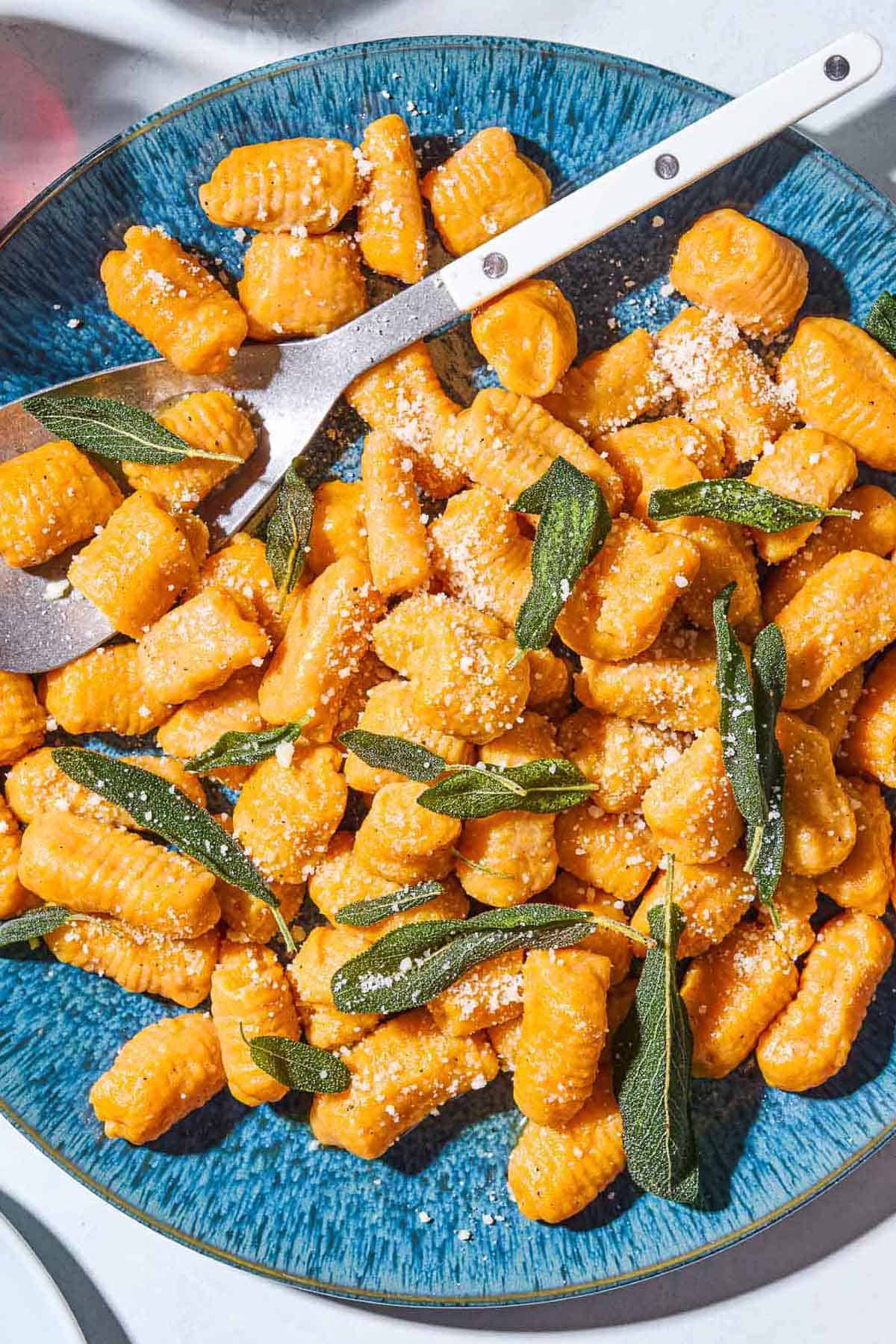
How to Make Sweet Potato Gnocchi
Sweet potato gnocchi are not difficult to make, but they can be tricky, so be sure to follow the instructions carefully, and set aside some time so you can enjoy the process!
Prep the Sweet Potatoes
- Roast the sweet potatoes. Heat the oven to 400°F. Place 2 pounds sweet potatoes on a baking sheet and prick a few holes in them with a fork. Bake until they’re completely tender, 45 to 60 minutes.
- Cool and drain the sweet potatoes. Slice them open with a knife and let them cool briefly. Line a colander with a double layer of cheesecloth or paper towels and scoop the flesh into it. Squeeze or pat out as much liquid as you can. This step will rid the sweet potatoes of excess moisture and is especially important if you’re using moist, orange-fleshed potatoes. Let cool until barely warm.
Form the Sweet Potato Gnocchi
- Rice or mash the sweet potatoes. Sprinkle 1/2 cup of the 2 cups flour on a clean work surface. Measure out 2 full cups (about 1 pound) of the sweet potato flesh and feed it through a potato ricer onto the floured work surface. Or use a potato masher or a fork to mash the potatoes in a bowl and turn them out onto the work surface (reserve any leftover sweet potato for another use).
- Make the gnocchi dough. Sprinkle all but 1/4 cup of the remaining flour around the potato mound. Make a well in the mound and add the egg and salt into the well. With a fork, whisk the egg and salt together and begin to incorporate the potatoes and flour. Use a dough scraper to “chop” through the dough to help bring the ingredients together without overmixing. Sprinkle the remaining 1/4 cup flour over the dough mass and very lightly knead and pat the mixture until it forms a soft, shaggy ball. It should feel slightly tacky, maybe even a bit sticky. If the dough is too sticky to work, sprinkle in a little more flour, but be careful not to add too much, or to over-knead, as the dough will only get stickier as it continues to absorb flour. Cover the dough with a clean kitchen towel.
- Shape the gnocchi. Line two rimmed baking sheets with clean towels and lightly dust with flour. Have ready a fork or wooden gnocchi board for making grooves in the gnocchi. Sprinkle a small amount of flour on the work surface. Slice off a tangerine-size piece of dough and gently roll it out into a rope about 3/4-inch in diameter. Use the dough scraper or a knife to cut the rope into 1-inch nuggets. Sprinkle them lightly with flour.
- Shape the gnocchi. Roll the pieces of dough down the curved tines of the fork or down the length of the gnocchi board to create an indentation on one side and grooves on the other. Set the gnocchi on a prepared baking sheet, taking care to keep them separated. Continue to cut and shape the remaining dough, setting the gnocchi on the baking sheets as you work. You should end up with about 175 to 200 gnocchi. It sounds like a LOT, but believe me, they will go fast.
- Let the gnocchi dry. Let the trays sit uncovered for about an hour; this will help to form a “skin” on the surface of the gnocchi, which will keep them from sticking when cooked. If not cooking within a couple of hours, place the baking sheets in the refrigerator or in a cold spot. They will keep for several hours. Cook them directly from the refrigerator.
Cook the Sweet Potato Gnocchi and Make the Sage Sauce
- Boil a pot of water and warm a serving bowl. While the gnocchi are resting, bring a large pot of water to a boil over medium-high heat, and add a tablespoon of salt. Place a large oven-safe serving bowl in the oven and turn the oven on to its lowest setting to warm the bowl.
- Make the sauce. In a large skillet, warm 6 tablespoons olive oil and 2 tablespoons butter over medium-low heat until the butter is melted and begins to foam. Add 2 to 3 lightly crushed garlic cloves and cook for about 3 minutes, pressing down on the cloves to infuse the oil and butter with their flavor. Don’t let the garlic brown or it will make the sauce bitter. When you can really smell the garlic’s aroma, remove the cloves. Toss in the sage leaves and cook until they have wilted and are just beginning to turn crispy. Turn off the heat and cover the pan.
- Cook, sauce, and serve the gnocchi. When the water is boiling, carefully drop in a third to half of the gnocchi, depending on the size of your pot. As the water returns to a boil the gnocchi will start floating to the surface. Let them boil gently for about 3 minutes. They should be tender and fluffy, but still the slightest bit firm, with no taste of raw flour. Use a skimmer or slotted spoon to transfer the gnocchi to the warmed serving bowl. Spoon half the sauce on top, adding a splash or two of the cooking water if needed to loosen the sauce. Toss gently, then return the bowl to the oven while you cook the rest of the gnocchi. Once cooked, transfer them to the warmed bowl and spoon the rest of the sauce on top, adding more cooking water as needed to properly coat the gnocchi. Sprinkle a generous handful of Parmigiano cheese on top—about 1/2 cup—and serve.
Sweet Potato Gnocchi Tips
If you’re new to making gnocchi, here are some tips to help get you started. Don’t be intimidated — the more you practice, the easier it gets!
- Really drain those potatoes. Sweet potatoes, especially the less-starchy, orange-fleshed ones, hold a lot of moisture. Not draining them properly after baking will result in sticky dough that requires extra flour, which will make the gnocchi gummy.
- Go light on the flour. As with potato gnocchi, too much flour can make sweet potato gnocchi dense, gummy, and tough. Start by incorporating 2/3 of the flour and add more as needed. Add just enough for the dough to form a compact ball. It should stay together and be slightly tacky but not too sticky. Always use a light hand when mixing gnocchi ingredients. No heavy kneading here!
- Test the gnocchi. Whether you’re making classic potato gnocchi, ricotta gnocchi, or sweet potato gnocchi, it’s always a good idea to test cook a small sample to make sure the dough is the right consistency. Roll out a few and cook them in a pot of boiling water. The gnocchi should be light but not insubstantial.
- Don’t panic! It takes a little practice to make gnocchi and get the technique down. So give yourself some grace while you’re learning. Gnocchi also freezes beautifully so while this recipe takes some time, it’s wonderful to prep ahead of time for a future meal.
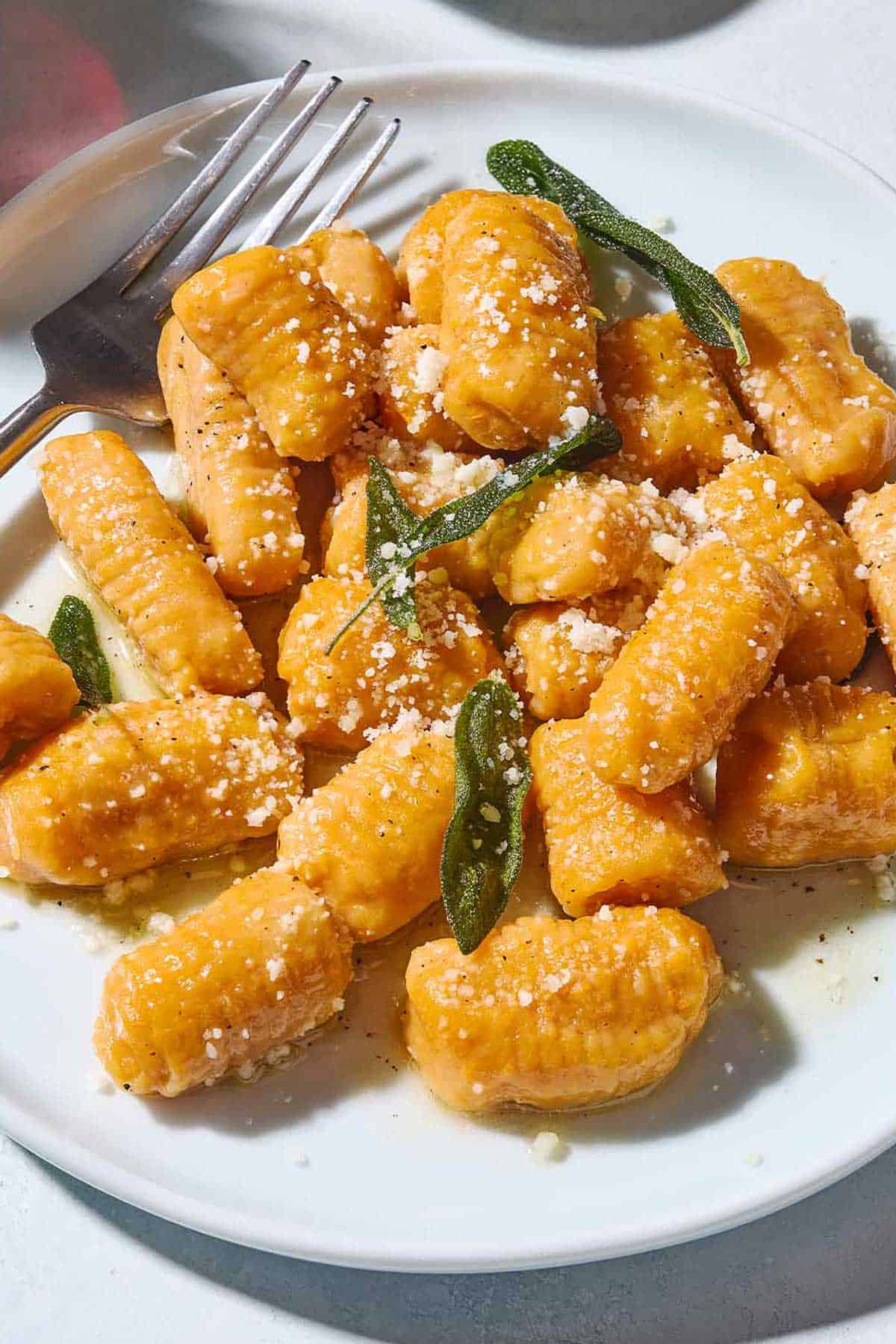
What to Serve With Sweet Potato Gnocchi
This vibrant fall dish is rich enough to be served as an entree, but you could also serve them as a prelude to a main course of Roast Chicken or Turkey Breast. To add even more autumn flavor, serve sweet potato gnocchi with little cubes of Roasted Butternut Squash and hazelnuts.
I love to pair these gnocchi with a crunchy fennel salad with shaved parmesan and toasted walnuts for a little contrast in textures. Radicchio Salad with sweet citrus and juicy pears would also be delicious.
More Gnocchi Recipes to Try
Browse all Mediterranean recipes.
Visit Our Shop.
Sweet Potato Gnocchi

Ingredients
For the gnocchi:
- 2 pounds sweet potatoes, scrubbed
- 2 cups unbleached all-purpose flour, plus more as needed
- 1 large egg
- 3/4 teaspoon fine sea salt, plus more to season cooking water
For the sauce:
- 6 tablespoons extra virgin olive oil
- 2 tablespoons unsalted butter
- 2 to 3 garlic cloves, lightly crushed
- 20 Fresh sage leaves
- Freshly-grated Parmigiano-Reggiano cheese, for serving
Instructions
- Roast the sweet potatoes. Heat the oven to 400° F. Place the sweet potatoes on a baking sheet and prick a few holes in them with a fork. Bake until completely tender, 45 to 60 minutes.
- Cool and drain the sweet potatoes. Slice them open with a knife and let them cool briefly. Line a colander with a double layer of cheesecloth or paper towels and scoop the flesh into it. Squeeze or pat out as much liquid as you can. This step will rid the sweet potatoes of excess moisture and is especially important if you’re using moist, orange-fleshed potatoes. Let cool until barely warm.
- Rice or mash the sweet potatoes. Sprinkle 1/2 cup of the 2 cups flour on a clean work surface. Measure out 2 full cups (about 1 pound) of the sweet potato flesh and feed it through a potato ricer onto the floured work surface. Or use a potato masher or a fork to mash the potatoes in a bowl and turn them out onto the work surface (reserve any leftover sweet potato for another use).
- Make the gnocchi dough. Sprinkle all but 1/4 cup of the remaining flour around the potato mound. Make a well in the mound and add the egg and salt. With a fork, whisk the egg and salt together and begin to incorporate the potatoes and flour. Use a dough scraper to “chop” through the dough to help bring the ingredients together without overmixing. Sprinkle the remaining 1/4 cup flour over the dough mass and very lightly knead and pat the mixture until it forms a soft, shaggy ball. It should feel slightly tacky, maybe even a bit sticky. If the dough is too sticky to work, sprinkle in a little more flour, but be careful not to add too much, or to over-knead, as the dough will only get stickier as it continues to absorb flour. Cover the dough with a clean kitchen towel.
- Shape the gnocchi. Line two rimmed baking sheets with clean towels and lightly dust with flour. Have ready a fork or wooden gnocchi board for making grooves in the gnocchi. Sprinkle a small amount of flour on the work surface. Slice off a tangerine-size piece of dough and gently roll it out into a rope about 3/4-inch in diameter. Use the dough scraper or a knife to cut the rope into 1-inch nuggets. Sprinkle them lightly with flour. Roll the pieces of dough down the curved tines of the fork or down the length of the gnocchi board to create an indentation on one side and grooves on the other. Set the gnocchi on a prepared baking sheet, taking care to keep them separated. Continue to cut and shape the remaining dough, setting the gnocchi on the baking sheets as you work. You should end up with about 175 to 200 gnocchi.
- Let the gnocchi dry. Let the trays sit uncovered for about an hour; this will help to form a “skin” on the surface of the gnocchi, which will keep them from sticking when cooked. If not cooking within a couple of hours, place the baking sheets in the refrigerator or in a cold spot. They will keep for several hours. Cook them directly from the refrigerator.
- Boil a pot of water and warm a serving bowl. While the gnocchi are resting, bring a large pot of water to a boil over medium-high heat, and add a tablespoon of salt. Place a large serving bowl in the oven and turn the oven on to its lowest setting to warm the bowl.
- Make the sauce. In a large skillet, heat 4 tablespoons olive oil and 2 tablespoons butter over medium-low heat. When the butter is melted and begins to foam, add the garlic and cook for about 3 minutes, pressing down on the cloves to infuse the oil and butter. Don’t let the garlic brown. When you can smell the garlic’s aroma, remove the cloves and stir in the sage leaves, Cook on medium-low until wilted and just starting to crisp—about 3 minutes. Turn off the heat and cover the pan.
- Cook and serve. When the water is boiling, carefully drop in the gnocchi. Cook in batches to avoid overcrowding the pot. As the water returns to a boil the gnocchi will start floating to the surface. Let them boil gently for about 3 minutes, just enough to make them tender, but still the slightest bit firm, with no taste of raw flour (taste one to make sure). Use a skimmer to transfer the gnocchi to the warmed serving bowl. Spoon half the sauce on top, adding a little cooking water if needed to loosen the sauce. Toss gently and slide the bowl back into the oven. Cook the remaining gnocchi and transfer them to the warmed bowl. Spoon the rest of the sauce on top, adding more cooking water if needed to coat the gnocchi. Sprinkle Parmigiano cheese on top and serve.
Notes
- Shop this recipe: Visit our shop to browse quality Mediterranean ingredients including the olive oil used in this recipe.
- Best sweet potatoes for gnocchi? Slender and long in shape, Garnet sweet potatoes have bright orange flesh that is super sweet and smooth when cooked. For gnocchi with that glowing orange hue, this is your best bet. Just know that because garnet sweet potatoes have a fair amount of moisture, they need to be drained. Rounder and fatter Beauregard and Jewel sweet potatoes have pretty orange flesh. They can be more fibrous than the Garnet variety, so be sure to rice or mash them thoroughly. You can also use white or purple sweet potatoes to make sweet potato gnocchi of different hues.
- Really drain those potatoes. Sweet potatoes, especially the less-starchy, orange-fleshed ones, hold a lot of moisture. Not draining them properly after baking will result in sticky dough that requires extra flour, which will make the gnocchi gummy.
- Go light on the flour. As with potato gnocchi, too much flour can make sweet potato gnocchi dense, gummy, and tough. Start by incorporating 2/3 of the flour and add more as needed. Add just enough for the dough to form a compact ball. It should stay together and is slightly tacky but not too sticky. Always use a light hand when mixing gnocchi ingredients. No heavy kneading here!
- Taste test the gnocchi. Whether you’re making classic potato gnocchi, ricotta gnocchi, or sweet potato gnocchi, it’s always a good idea to test cook a small sample to make sure the dough is the right consistency. Roll out a few and cook them in a pot of boiling water. The gnocchi should be light but not insubstantial.
- Storage: Store gnocchi for up to several hours in the refrigerator. For longer storage, line a rimmed baking sheet with a clean tea towel and coat it with flour. Arrange the gnocchi on the baking sheet, making sure they are not touching. Freeze until solid (a couple of hours). After that, you can transfer them to an airtight container or freezer bag and return them to the freezer for up to a month. Do not defrost the gnocchi before cooking them; just plunge them into a pot of boiling water and cook as directed. You may need to extend their cooking time briefly, but not much.
- Serving size: This recipe makes about 200 gnocchi, which can serve up to 8 people with 25 gnocchi per person. However, if you cut the gnocchi in larger pieces, you will end up with fewer gnocchi, so assume this recipe serves 6 to 8 people based on how you cut your gnocchi. The nutritional information is based on 8 servings.
Nutrition
Bundle and Save!
Four of our best-selling signature olive oils, perfect for everyday use.
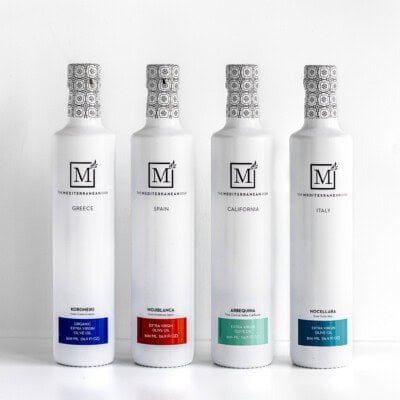




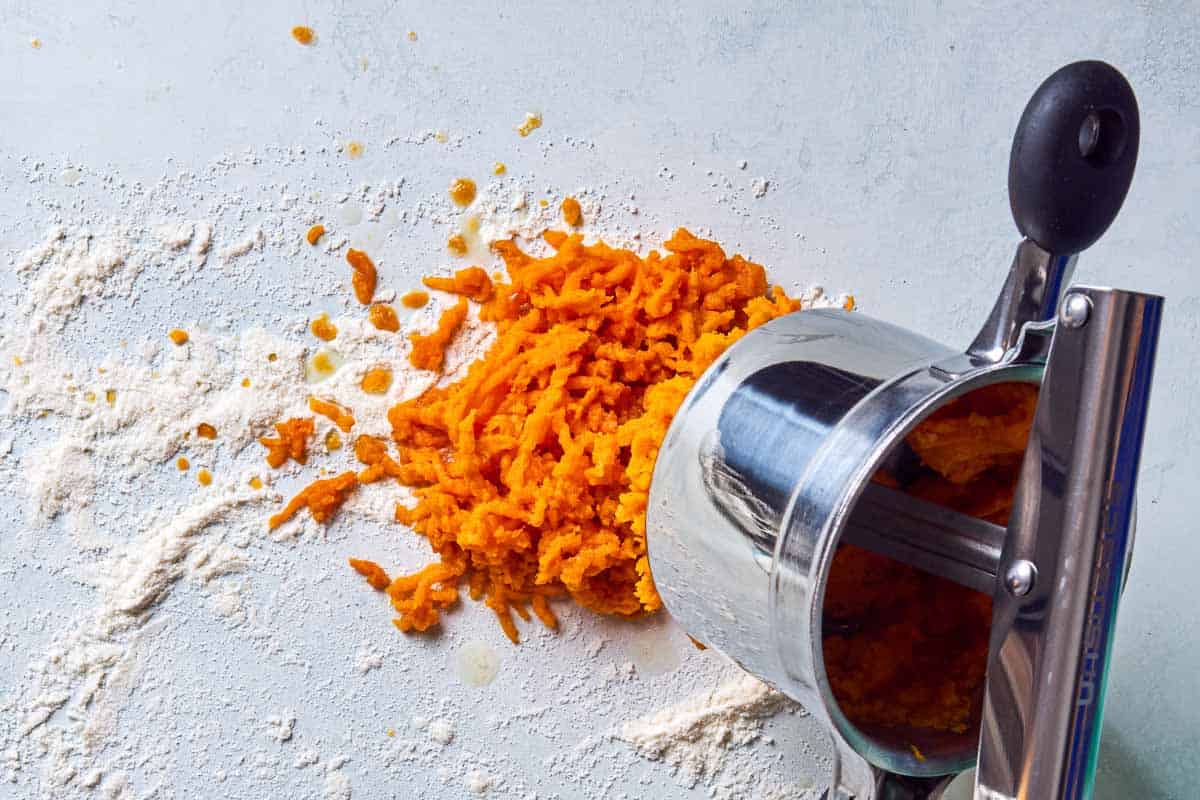
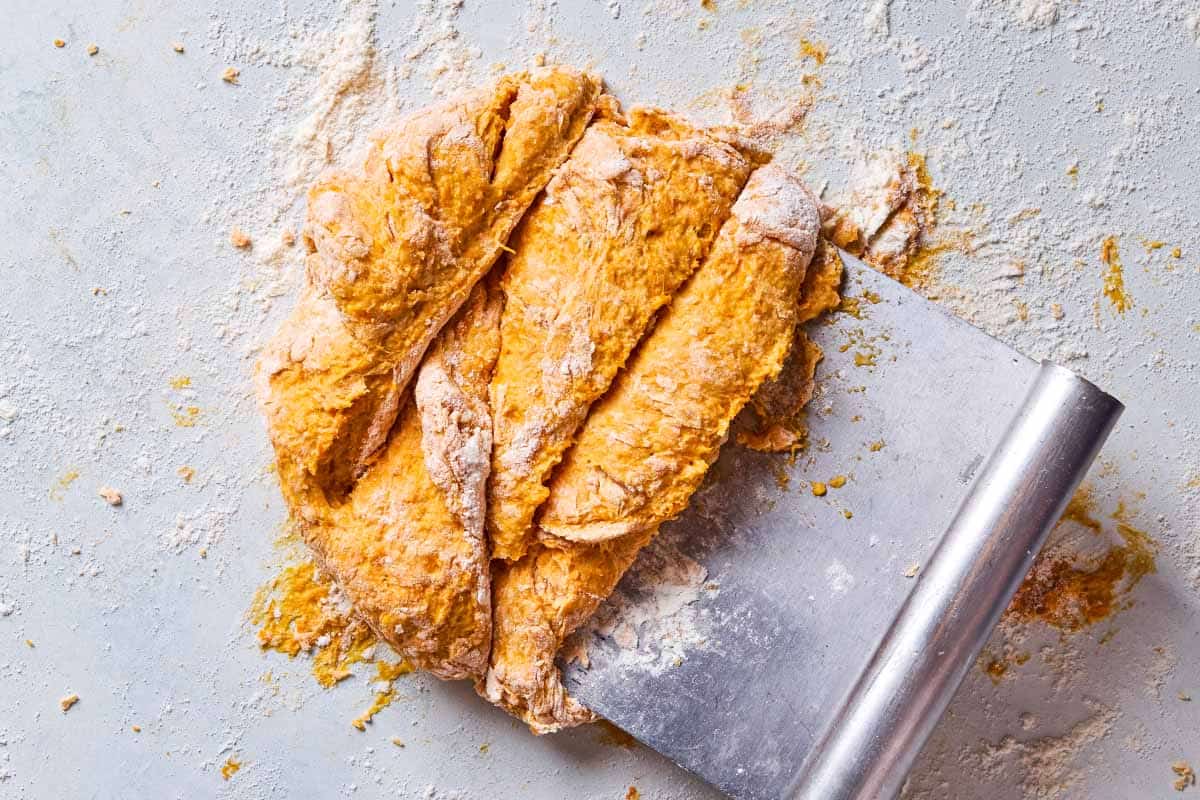
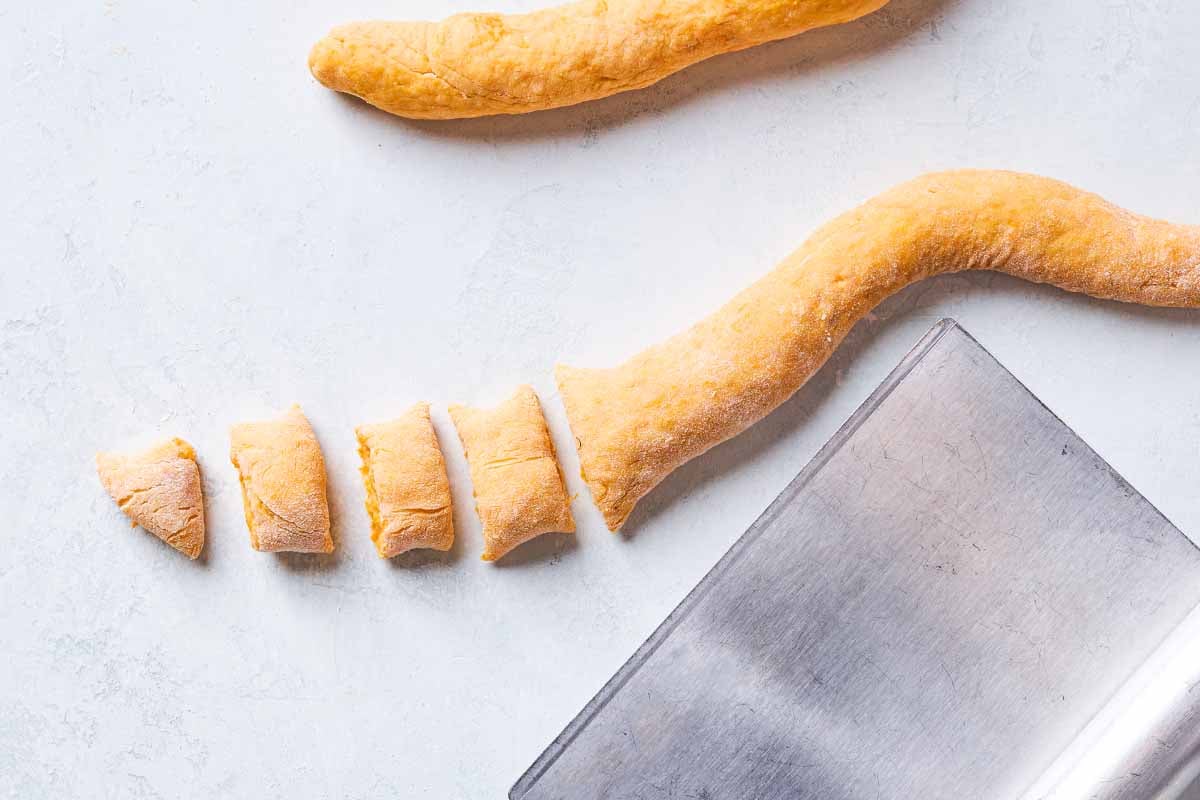
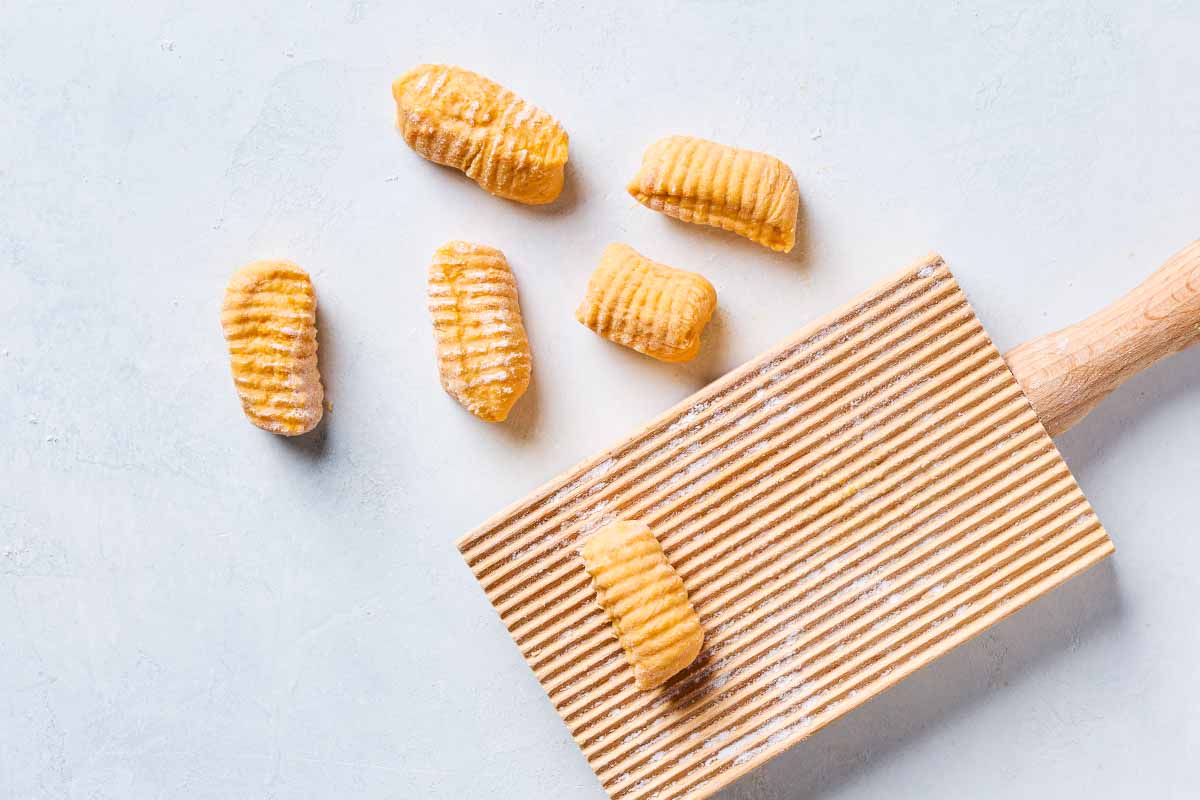
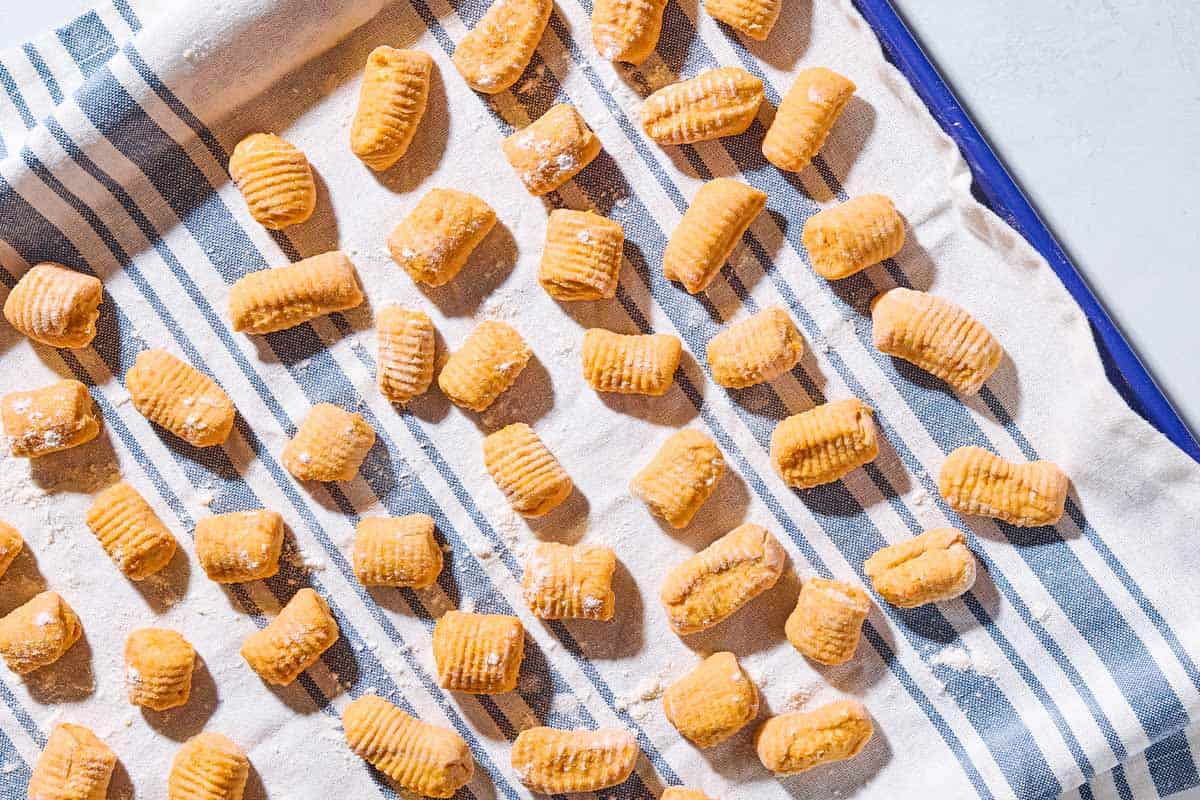
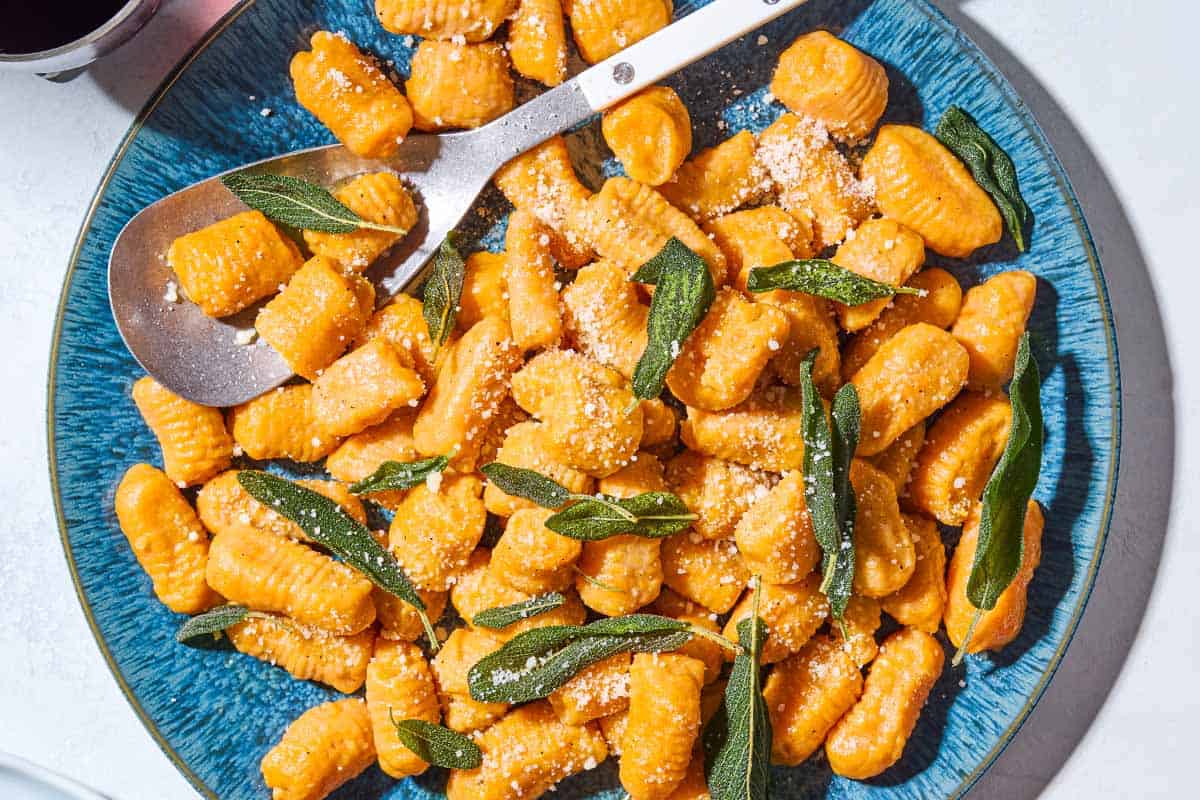


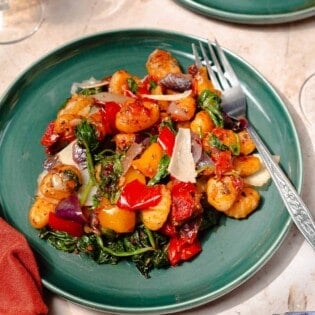
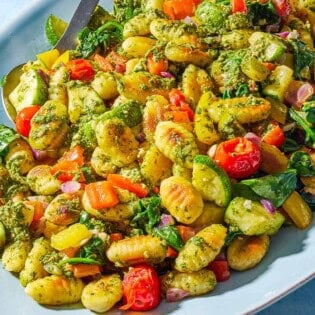
I want to try this recipe, but I will be substituting the flour with chickpea flourand adding in ricotta cheese